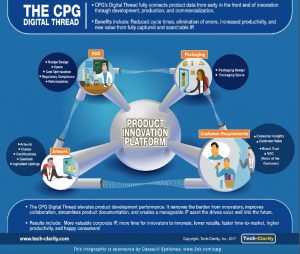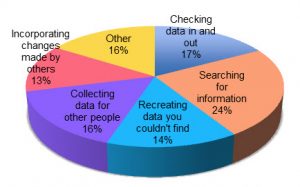
Guest post by Jim Brown, President, Tech-Clarity
The Innovation Imperative
Now, more than ever, consumer packaged goods (CPG) companies need to innovate. Today’s corporate strategies demand growth despite slowing market expansion. In order to grow in this environment, companies need to do more than win their fair share of consumer buying decisions. They need to outmaneuver their competition.
Leading CPG companies know how to survive challenging market conditions. They recognize that consumers reward fresh ideas and innovative products at the shelf. But consumer demands have changed and product developers need to adapt their innovation strategies. Consumers want more out of their products and their relationship with a brand. They want it to be personal. Products have to meet regional desires, but go beyond that to be tailored to more specific preferences.
How can companies develop more customized products to drive profitable growth? They need to institutionalize innovation and fundamentally change the consumer relationship.
Taking Innovation to the Next Level
CPG companies need to get more out of every innovation investment. It’s time to synchronize and integrate the entire product innovation and new product development process so they can respond to demands almost instantaneously. That means that different departments and the supply chain have to work together. They need to collaborate on ideas and put the innovative power of everyone to use without the wasted time and effort that companies currently consider acceptable.
How can they eliminate non-value-added work and harness the combined innovation power of the value chain? They have to take a cohesive approach to product innovation, R&D, product development, and new product introduction instead of treating these as individual efforts. They can’t afford to recreate information or reconcile data at each step. It needs to be the result of an integrated process where each person adds directly to the work done by others.
The Product Innovation Platform
The integrated innovation process requires more than an integrated process. It demands integrated data. As our guest post, Innovation Platforms – the Operating System for the Digital Enterprise explains, the PIP provides an integrated model that eliminates the need for a lot of non-value-added work like translating and recreating data, resulting in a single digital thread that connects information and people across the product lifecycle. It provides cohesive product model that pulls together formulas, packaging, labeling, artwork, compliance, and more so that everyone is working on the same information. Instead of accessing information from another department and creating their own data, product developers add to a central model.

The PIP keeps all aspects of the product together so when a change occurs, like an upgrade to marketing claims or a certification, the impact can be managed across the digital model. In this example, the change would be visible to others so that specifications, artwork, testing, and other elements of the product stay in sync. The result is an integrated digital thread of information.
Taking Products to the Next Level with the PIP
A cohesive Digital Thread requires the integration available from the Product Innovation Platform. First, it allows them to leverage analytics to gain new consumer insights to innovate to customer preferences. Then, it leverages mathematical and scientific models to simulate the product, for example to optimize packaging designs. It can even reach beyond the product to the shelf by modeling and validating a better consumer experience, simulating merchandising decisions to fine tune the buying experience using advanced capabilities including virtual reality (VR).
The PIP can help CPG companies with brand new products or smaller efforts like a reformulation or other micro innovation that keeps the product interesting and drives perceivable (and promotable) consumer benefits. These innovations can be anything from a new fragrance to an ingredient change that allows a price reduction for the consumer. The integrated nature of the PIP makes it easy to use the product as the basis for something new, or reuse the existing model to incrementally improve a product to keep it fresh in the consumers’ eyes.
Taking NPDI to the Next Level with the Product Innovation Platform
Of course CPG companies know that commercial success demands more than a great product. A PIP manages more than R&D data. The full product model and Digital Thread also addresses commercial information in context.
Beyond that, the PIP also integrates innovation projects. It can manage the full scope of the NPDI project by tying in different departments and the value chain. As they contribute to design deliverables, their work updates project status. This makes status reporting more efficient and provides a much more accurate picture of progress.
Finally, the PIP reaches beyond R&D to make it easy to hand off a complete spec to manufacturing. Then, manufacturing can extend the model with production processes. The integrated PIP allows product innovators to provide complete information to the plant to drive consistent products at high quality and productivity, typically transferring the data to manufacturing ERP software and or Manufacturing Execution System (MES) software / Manufacturing Operations Management (MOM) software for execution.

The Status Quo Isn’t Good Enough
CPG companies were slower to start their PLM journeys, but have been investing in more recent years. PLM is the right direction, but the early PLM systems focused primarily on managing disparate files. This resulted in significant non-value-added work in managing data. As Tech-Clarity’s Michelle Boucher reported in her Accelerate Innovation with Less NVA Work webcast and whitepaper, consumer goods companies spend 34% of their time on non-value added work. Much of this time is spent searching, finding info for others, and recreating data people can’t find (see graphic). This is simply not good enough for the innovation agility needed for today’s markets.
Time to Adopt the Product Innovation Platform in CPG
The fundamental value of the PIP is that it not only integrates different aspects of product data, but it also manages information as digital data that can be easily accessed. This allows applications (apps) to access data and get the piece of information a person needs for the task at hand without searching for a document and having to interpret the information on their own. This allows the PIP to provide more information while simplifying things for users.
The PIP gives innovators the tools they need to change the relationship with consumers and to deliver products that delight them. The PIP is the fundamental capability needed for CPG companies to make the transition to the digital enterprise to improve innovation, agility, and speed while maintaining quality and competitive costs. It’s time for CPG companies to go beyond the boundaries of traditional business, deliver new levels of value to customers and shareholders alike, and deliver profitable growth despite challenging times.
………
Watch this video to see how the Dassault Systèmes 3DEXPERIENCE platform is helping CPG companies accelerate innovation and deliver growth in the experience economy.

